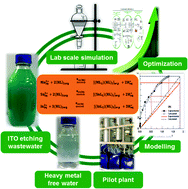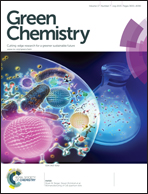Commercial process for the recovery of metals from ITO etching industry wastewater by liquid–liquid extraction: simulation, analysis of mechanism, and mathematical model to predict optimum operational conditions†
Abstract
A commercial process for the recovery of metals from the indium-tin-oxide (ITO) etching industry wastewater by liquid–liquid extraction has been developed. A suitable cross current simulated batch process was developed, and extraction mechanisms involved in the process were analyzed. Mathematical models were proposed to correlate metal extractability with respect to extractant concentrations and metal loading with respect to the solvent/solution volume ratio. Optimum conditions required for the complete scrubbing of Mo and Sn using Cyanex 272 and quantitative extraction of pure In using DP-8R were estimated by a proposed model. A good agreement between the proposed model and the observed results was found. Based on the laboratory scale simulation, a pilot plant batch process was developed and simulated. The developed process is a techno-economically feasible, environmentally friendly, occupationally safe, and clean and green process for the commercial treatment of ITO etching industry wastewater and recovery of valuable metals through liquid–liquid extraction. In with 99.999% purity, Cu nanopowder with 99.999% purity, Mo and Sn with 99% purity were recovered.



 Please wait while we load your content...
Please wait while we load your content...